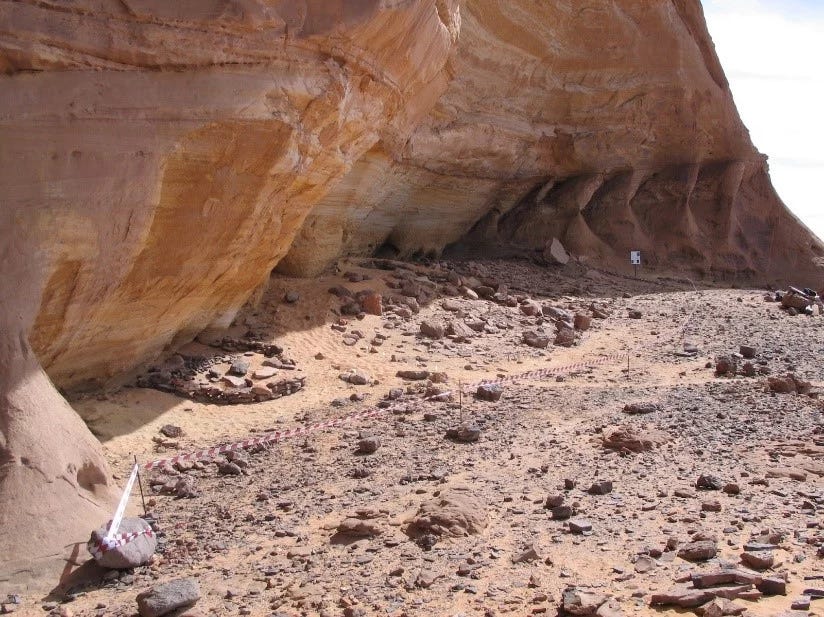Once a fertile expanse teeming with lakes, grasslands, and abundant wildlife, the Sahara was a starkly different landscape than the inhospitable desert known today. During the African Humid Period (14,500–5,000 years ago), this region supported thriving human populations. Now, an international team of researchers1 has uncovered the first ancient genomes from this long-lost ecosystem, shedding new light on an ancient North African lineage that has all but disappeared.

By analyzing DNA from two 7,000-year-old naturally mummified individuals found in the Takarkori rock shelter of southwestern Libya, researchers have identified a genetic signature distinct from both sub-Saharan and Eurasian populations. Their findings, recently published in Nature, challenge existing models of early human migration and isolation in North Africa.
"This discovery reveals a deeply rooted and long-isolated genetic lineage in North Africa," said Nada Salem of the Max Planck Institute for Evolutionary Anthropology, the study’s lead author. "The genetic continuity we see suggests that some populations in this region remained isolated for tens of thousands of years."
A Lineage Frozen in Time
The genomes of the Takarkori individuals indicate that their ancestors split from other human populations around the same time that early Homo sapiens left Africa roughly 50,000 years ago. Instead of dispersing into Eurasia, these early North Africans appear to have remained genetically distinct, forming a population that persisted in relative isolation well into the Holocene.
This ancient group shares ancestry with the 15,000-year-old foragers of Taforalt Cave in Morocco, associated with the Iberomaurusian culture. However, both populations appear equally distant from sub-Saharan African groups, challenging previous theories that the Green Sahara served as a genetic bridge between sub-Saharan and North African populations.
"Despite the Sahara’s transformation into a lush, habitable landscape, gene flow between sub-Saharan and North African groups remained minimal," said Johannes Krause, a senior author of the study. "This contradicts the long-held assumption that the African Humid Period facilitated large-scale genetic mixing across the continent."
Neandertal DNA and the Origins of North African Ancestry
Another striking discovery concerns the presence of Neandertal DNA in the Takarkori individuals. While they carry significantly less Neandertal ancestry than non-Africans, they still show slightly higher levels than contemporary sub-Saharan Africans. This suggests limited genetic exchange between early North African populations and Eurasian groups that interbred with Neandertals before returning to Africa.
"Our findings indicate that early North Africans were largely isolated, yet they received small amounts of Neandertal DNA from interactions with groups outside of Africa," Krause noted.

The Spread of Pastoralism: Migration or Cultural Diffusion?
The study also provides new insights into the origins of pastoralism in the region. By 7,000 years ago, evidence suggests that herding and livestock management were well established in the Green Sahara. However, genetic data from the Takarkori individuals do not support a large-scale migration of people introducing pastoralism from the Near East. Instead, the researchers propose that herding may have spread through cultural transmission rather than population replacement.

"This research challenges the idea that early pastoralism in North Africa was driven by migrating herders from the Levant," said Savino di Lernia of Sapienza University in Rome. "The evidence instead points to a model where existing North African populations adopted livestock management through contact with neighboring groups."
Implications for North African Prehistory
This discovery reshapes the understanding of early human history in North Africa, emphasizing the complexity of ancient population dynamics in the Sahara. While the Takarkori lineage has since disappeared in its pure form, its genetic legacy endures in modern North African populations.
"Ancient DNA allows us to reconstruct human history in unprecedented ways," said David Caramelli of the University of Florence. "By examining these ancient genomes, we can trace the deep history of populations that once thrived in the Sahara and see how their genetic imprint persists today."
As researchers continue to analyze ancient DNA from North Africa, the genetic history of the Green Sahara may reveal further surprises—perhaps even new insights into the early migrations that shaped modern human populations across the continent.
Additional Related Research
Skoglund, P., & Reich, D. (2016). A genomic view of the peopling of the Americas. Science, 354(6309), 163–165. DOI: 10.1126/science.aaf6410
Discusses ancient human migrations and genetic continuity, which parallels the findings in North Africa.
van de Loosdrecht, M. S., et al. (2018). Pleistocene North African genomes link Near Eastern and sub-Saharan African human populations. Science, 360(6388), 548–552. DOI: 10.1126/science.aar8380
Explores the genetic history of prehistoric North African populations and their links to neighboring regions.
Hollfelder, N., et al. (2017). Northeast African genomic variation shaped by the continuity of indigenous groups and Eurasian migrations. PLoS Genetics, 13(8), e1006976. DOI: 10.1371/journal.pgen.1006976
Investigates how ancient and modern North African populations have been shaped by migration and isolation.
These studies provide additional context for the Takarkori findings, enriching the broader discussion of ancient human migration, genetic isolation, and cultural exchange in North Africa.
Salem, N., van de Loosdrecht, M. S., Sümer, A. P., Vai, S., Hübner, A., Peter, B., Bianco, R. A., Lari, M., Modi, A., Al-Faloos, M. F. M., Turjman, M., Bouzouggar, A., Tafuri, M. A., Manzi, G., Rotunno, R., Prüfer, K., Ringbauer, H., Caramelli, D., di Lernia, S., & Krause, J. (2025). Ancient DNA from the Green Sahara reveals ancestral North African lineage. Nature, 1–7. https://doi.org/10.1038/s41586-025-08793-7










Share this post